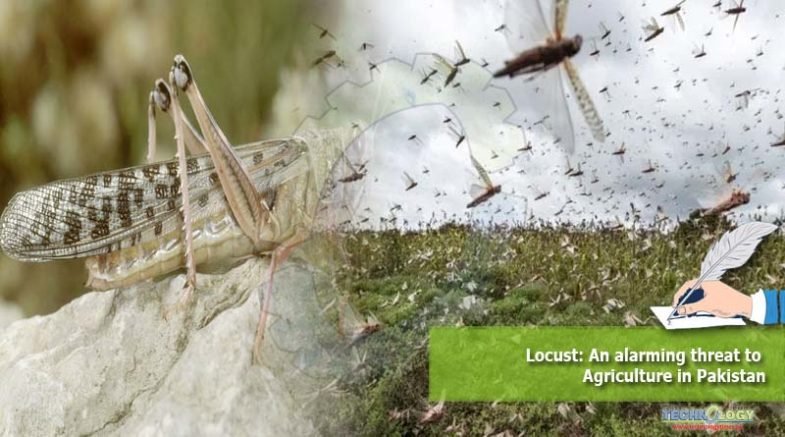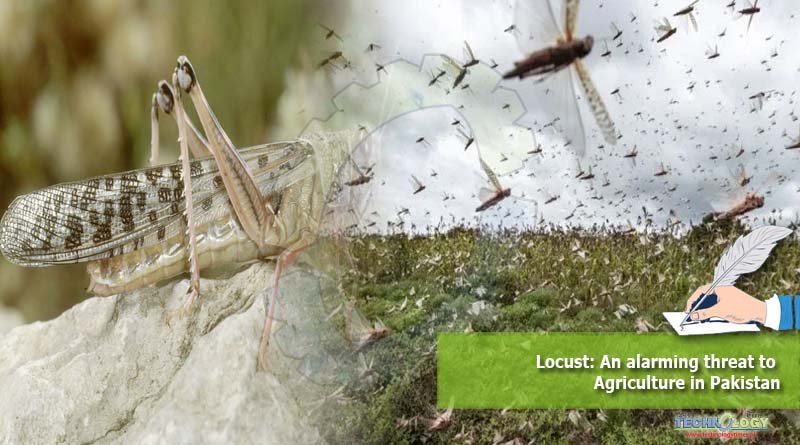Locust is an insect that belongs to the family Acrididis from the orthoptera order. This is a short-horned insect that differs from the insect in the sense that it can behave in a large crowd.

They change their behavior in the phase called the gregarious phase. When environmental conditions are suitable and greener matter is available; they reproduce. Locusts don’t react individually and they behave like a heavy band of hoppers and adults as a swarm. Locusts can change their ecological area and food requirements, therefore they move and settle in new areas and adjust themselves according to their habitat. They have the capability of flying over a long distance. A female locust can lay eggs ranging from 80 to 150 in numbers.
Locust numbers will increase further from widespread hatching in India and the second generation of breeding in Pakistan, giving rise to additional hopper bands in August and adult swarms in September. The most devastating of all locust species is the Desert Locust. During plagues, it can easily affect 20% of the earth’s land, more than 65 of the world’s poorest countries, and potentially damage the livelihood of one-tenth of the world’s population.
Locust has a high capacity to multiply, form groups, migrate over relatively large distances (they can fly up to 150 km per day) and, if good rains fall and ecological conditions become favorable, rapidly reproduce and increase some 20-fold in three months.
Locust adults can eat their weight every day, which is about 2 grams of fresh vegetation per day. A swarm the size of Bamako, Niamey or Paris will consume the same amount of food in a single day as half the population of Mali, Niger, and France respectively. If
Locusts situation in Pakistan:
The pest attack is not new in Pakistan. Pakistan is also targeted by pest attacks in past decades and cause heavy loss to the agriculture in the 1950s, 1960s and 1990s. Locusts start its voyage from countries of the African sub-continent and after progressing through Yemen, Iran and Saudi-Arabia reach Pakistan through the south-west coastal areas in Baluchistan where it starts breeding in March. The locusts enter into the Nara desert of Sindh province after hatching of the eggs.
The first attack of insects reported in early June and have entered from the west side of the country from Iran. Now locusts swarm infest various districts of Sindh including Khairpur and destroy the crop.
Food and Agriculture Organization (FAO) has declared a warning about the potential threat to crops from the onslaught of locust in Punjab and Sindh provinces. Local authorities express satisfaction over the counter-measures being taken in the affected areas.
According to Punjab government, the locusts have been under control in the Cholistan, a hotspot in the southern parts of the province. Locusts have started to spread in areas of southern Punjab, locals continue to invade Vehari and Arifwala. Crops worth crores of rupees are feared to be destroyed.
Locals in Vehari’s suburban village Pakhi Mood, 19 WB, 21 WB, 23 WB, 49 WB, 51 WB, and other areas, including sugarcane and maize, have been carrying out locust attacks. After attacking crops in Arifwala, the locust has entered the heart of the city, causing millions of locusts in the urban airspace.
The local administration is spraying to control the situation, with no results. Farmers demand that effective measures be taken to eradicate Locusts. Pesticides have been sprayed on the area of more than 6,000 acres, using a specially designed aircraft, vehicles, and camels.
However, as per the evaluation of FAO, in Southwest Asia, substantial ground control operations are in progress against numerous spring-bred swarms of desert locust that appeared in Rajasthan, India during July and laid eggs, which hatched and caused hopper groups and bands to form Smaller operations are underway in adjacent areas of Pakistan.
Locust swarm entered Khyber Pakhtunkhwa via the Bhakkar area of Punjab. It can cause damage to wheat and cotton crops and palm gardens in the heart of the area. To prevent the onslaught of the farms, the Agriculture Department has launched an awareness campaign in the area.
The Khyber Pakhtunkhwa government announced an emergency to control the invasion of locust swarm and soil in nine southern districts of the province following the entry of large swarms of pest to Dera Ismail Khan district. Locust infestation creates an emergency situation in Dera Ismail Khan, Tank, Lakki Marwat, Bannu, Karak, Kohat, Hangu, North and South Waziristan districts.
The government of Pakistan scared of the swarms that it may strike cotton crops, a crucial source of income for its weak economy. Pakistan is desperate to prevent further decline in its cotton industry as it seeks to shore up its economy after securing a bailout package from the International Monetary Fund last month. The country’s textile industry is its biggest job provider as well as its largest foreign exchange earner. Pakistan mainly depends on home-grown cotton for its textile industry. Unfortunately, despite the announcement of the government’s national emergency, farmers in different cities are waiting for help. Prime Minister Imran Khan’s government has deployed aircraft and spray-mounted vehicles to treat about 10,000 acres in the southern province as a preventative measure.
Although locusts are big issue for Pakistan’s agriculture sector but government is taking steps to cope with this issue.
Authors: Gulnaz Anwar1, Dr. Zubair Aslam1, Ali Ahmad1, Sami-ur-Rehman1.
1Department of Agronomy, University of Agriculture Faisalabad.
